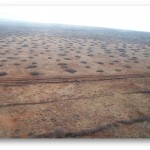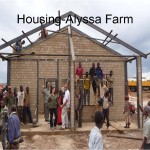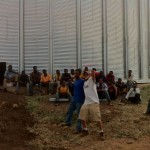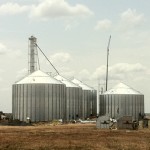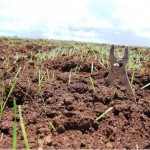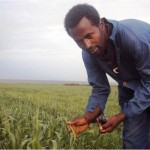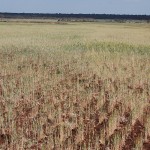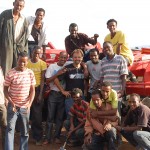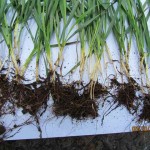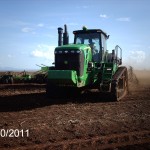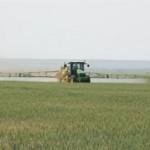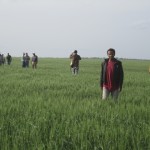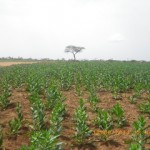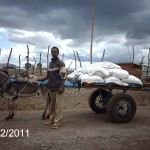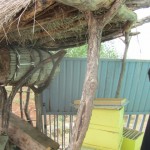Following the success of the first test of the dry farm initiative, MAI decided that the next step would be to plant additional drought-resistant crops and to create a large seed farm.
In December of 2009, the Ethiopian government made available a huge section of 10,000 hectares, or about 25,000 acres, of land to MAI for the establishment of the seed farm. This land was intended for the planting of imported seed such as wheat, barley, and any other seeds the government needed. These seeds will eventually be for sale and distribution in the area and the whole country.
In order to find a vacant section of land of this size, the property was remotely located a few hundred miles from the Somalia border. Approximately a twelve hour drive from the company’s other farms, the seed farm, and the biggest MAI project yet, is located in the area of Beltu. Beltu is located at 5,500 feet above sea level in a mild climate. The farm is lovingly named “Alyssa” after the farm manager’s wife.
The Alyssa farm is managed by Wes and Alyssa Haws and Mark and Heidi Brown. The property leased was uncultivated and harsh, and land clearing on the farm was a challenge, to say the least. Mark Brown and Wes Haws had to begin the process by experimenting with different methods of clearing.
Manual labor was the first implemented method of land clearing used on the Alyssa farm. Local Ethiopian workers were paid by the hour, by the day, to pull out weeds, hard bushes, and trees. Three weeks went by, and only 60 hectares had been cleared. It was then determined that this was not the most effective method to clear the entire 10,000 hectare farm in a timely manner.
So, MAI hired InfoMind, a human resource management company in Ethiopia, to assist in the hiring of local people to work the farm. When large numbers of workers had to be hired quickly, the knowledge and resources of InfoMind became invaluable. This company managed the hiring, paying, management, and firing of staff on the farm in Beltu.
It was also determined that workers on the farm should be paid on a per-hectare basis, rather than by the hour. Land clearing on the farm began to progress much quicker. In one week, six to seven hundred hectares could be cleared.
When MAI, with the help of InfoMind, started contracting the land clearing effort out in a per-hectare basis, they allowed the local communities to form their own teams. They were no longer hiring individuals, but rather sub-contractors. The communities would form groups of ten to fifteen people, and they would contract to clear a specified amount of hectares.
Once the community teams were organized, MAI would send the groups out to a set area to clear the ground. Quality assurance employees would evaluate whether or not the clearing was done up to standard, and they would sign off on the land parcel before the workers could be paid.
Conflicts
The main conflict that arose while working on the land clearing at the Alyssa farm came from the local farmers in the area. MAI would pay the local Ethiopians to clear their own farm land, which they would, but the people would then fight with MAI employees about moving off of the property. They wouldn’t let the land be plowed and planted, even though Morrell Agro Industries leased 10,000 hectares from the Ethiopian government. As part of this agreement, the government surveyed the property and identified any people who resided in the area. They were then to compensate the people, by buying the property from them, and the land would be vacated. The property was to be bought with MAI’s lease payment. The lease payment had been made, but the government payments to the local people were slow in coming, creating land conflicts.
Only two or three percent of the property is actually occupied, but the Ethiopian people do not want MAI to plow the land that they have not been paid for. Their homes are on the land, and it is reasonable that they do not want to move without the proper compensation.
MAI once received a machete through the front of one of their tractors that the local people believed was too close to their property. They do, however, recognize that it is a government problem. But, at the same time, they want to protect what is theirs, and anyone in the same shoes would feel in a similar way.
The problem escalated to new heights one morning, however. On Monday, August 23, 2010, at about 11:30 am, Wes Haws of the Alyssa Farm, was attacked by an angry mob over a land dispute. He was struck on the back of the head with an axe.
On her blog, Shelley Baum, a farm manager, describes her husband, Alan, running into the yard and quietly but urgently saying, “Where’s the satellite phone, I need it now, Wes has been shot!” Scared for Wes and his family, Shelley confirmed that his wife, Alyssa, was with him and ran to find the first aid kit at Wes’s house. Alan was busy calling the office in Addis Abada and quickly arranged a flight to get him there.
After an interrogation, it was found out that Wes was outside the farm with a land clearing crew opening up some new land. Some villagers were there and were trying to stop the land clearing because they claimed they had not had compensation and felt that MAI was trespassing. Barouk, a GPS operator, was ahead of Wes and the dozer trying to figure out where to strike a line. Some people from a nearby small farm were there as well as the villagers. They warned Barouk and Kadir, telling them to stop and go back to the farm. Barouk and Kadir told Wes that they were in danger and needed to leave; that they were threatening to kill him. One man tried to throw a rock and Wes grabbed the man’s arm, making him drop the rock. That man, threatening to shoot Wes, ran to one of the guards and tried to get the gun from him. Wes, being unaffected, took the GPS from Baruk and was looking at it when he was struck on the head from behind. Not realizing exactly what happened after receiving a blow to the head, Wes asked Baruk if he had been shot. Baruk and Kadir quickly got him to the land cruiser. Since Baruk doesn’t know how to drive, they managed to make it to the farm with Baruk steering and Wes shifting, even in his dire condition. They came roaring into the camp, the land cruiser going as fast as it could in first or second gear, and Alan went to see what was happening. Wes, with a shirt wrapped around his head, was helped out of the Land Cruiser by two men and told Alan he had been shot as he was rushed into the clinic. Alan could see the blood covering his shirt and ran for the satellite phone.
Alyssa and Abdul were there immediately. Everyone jumped into action at the clinic and did very well to take care of him and access his injuries. It then became clear from witnesses that he had received a blow to the head from an ax. Nate and Alyssa tried to stop the blood flow, but due to the fact that it was a head wound, there wasn’t much to be done. His skull was fractured from the blow to the right back of his head. There was a three to four inch gash and many bone fragments. His blood pressure and heartbeat were slowly dropping. They soon realized that Wes would have to be flown out of the farm if he were going to be saved. An emergency flight was arranged with Abyssinian Airlines, who got permission to fly through the no-fly zone covering a large area between the farm and Addis Abada. This cut down the flight time by 20 minutes. The plane arrived after a couple of hours and Wes was carefully taken in the back of a pickup truck over to the runway and loaded onto the plane. The plane was only grounded a total of about 15 minutes before it took off to Addis Abada with Wes and Alyssa and family.
At the airport in Addis Abada they were met with an ambulance and doctors who took him directly to the Korean hospital where he underwent a CAT scan. They did think about sending him for surgery to Cairo or Nairobi, which have larger hospitals, but decided against that and kept him in Addis Abada where he underwent brain surgery for 6 1/2 hours. It was fortunate that Wes was kept in Ethiopia because his brain was quickly swelling and there would have been no time for him to make it to another country.
It was heard the next morning that his skull was indeed fractured and there was damage to a sinus on the right side of the back of his head. He lost a lot of blood on the farm as well as in surgery. He was in a lot of pain and discomfort, but they decreased his sedation and pain medication because his heart rate and oxygen levels were very unstable and low. However, his heart rate and oxygen levels did not improve, so after a lot of consultation with his American doctors and his neurosurgeon there, they decided to send him to a very reputable and modern hospital in Tel Aviv, Israel where he would get much better care. Wes and Alyssa left on a medivac flight early Sunday, August 29th for Israel. Wes has been improving each day and miraculously, the doctor expects the only lasting effect he will have is a loss of 50% of his eye sight in the right of each eye. He is now back in the United States to receive additional care and on October 16th, 2010 Wes underwent an additional surgery to have a plate positioned in his skull, to cover the hole left by the axe.
Wally Odd flew into the Alyssa farm on the plane that took Wes Haws to Addis Ababa. He briefly took over Wes’ job on the farm, while organizing the employees there. Heidi Brown said that he set a plan in motion for the farm. He also took control of a few government issues from Mark Brown, to relive some of his many responsibilities.
When Alan Baum and other MAI employees mapped out the planted fields by GPS, the result was cut up sections here and there. It also showed the areas where ranchers and other local people would simply not let MAI tractors in to clear and plow the land. Some of the local people would create big thorny brush piles as a fence. Loaders could quickly push together the brush and burn it, but that would only increase the conflict with the neighbors.
Paul Morrell said, “I think [the compensation] they’re getting is fair. I think, they think that it’s fair. They just want to make sure that they get it before they start moving. They’ve got animals they’ve got to deal with… There is a lot of area out there to move; they can find another spot. But, it’s just the process that has to be taken care of.”
Worknesh Gebretensay and Paul Morrell met with everyone involved in the farmers compensation issue, including President Abdulla, on July 17, 2010. The case was presented and discussed. President Abdulla made the decision to transfer funds to the Woreda immediately. Compensating the individual farmers on the property in Beltu began the next week. Six-thousand hectares were paid in the first phase of compensation. So, 4,000 hectares remain of the 10,000 hectares that MAI has in Beltu. The people living on this last section of land should currently be being paid to leave.
Alan Baum said, “We’re trying to do a good thing. There’s a lot of people out there looking at us, hoping that this is a success. Even though we’ve had a lot of conflicts out there through that area, I get the feel that they want us there. They do. They just want to make sure they’re taken care of before they get cleared off their property.”
Paul Morrell said, “These people out here have never held a job in their life. They’ve never been paid wages in their life. They’ve never worked for wages a day of their life. All of this is brand new to them. They’ve never had taxes withheld from a paycheck before. That was a huge problem when they found out that part of their hourly wage went back to the government.”
At one point, MAI was employing 3,000 local people with work on the Alyssa farm. Other people had seen this work being done, and they came in and established a marketplace right on the farm. They set up their wares under tents or pieces of tarp, feeding people and making a lot of money. Employees of the farm would go there to buy food, radios, soda pop, and other things that they had never had before.
A few months after work began at the Alyssa farm, the Ethiopian government went throughout the country performing their annual food security survey. This survey calculates how much food they need to donate to the community, to make sure that their people don’t starve to death. For the first time in the history of the survey, the people in the Beltu region surrounding the Alyssa farm will not require government aid. This is due, in part, to the wages that MAI is paying the community to work for them.
Paul Morrell said, “We’re changing an entire culture in this area… 80% of them are positive changes and 20% are going to be negative changes, but overall I think it’s a great thing that these guys are doing out there.”
Building Infrastructure and Farm Conditions
When Mark Brown first arrived in Beltu, Ethiopia to work on the Morrell Agro Alyssa farm, there was no place for him, or any of the other farm workers to stay on the property. For awhile, the MAI employees working in the area lived in the town of Beltu and drove into the farm every day.
Currently, three houses have been built on the property. Two are functioning with showers and toilets, which are simple conveniences that make life easier on the farm. A dormitory facility has also been completed for workers on the farm, as MAI employees hundreds of local Ethiopian people.
A 183 meter pipe well was also dug on the farm, to provide MAI employees and farm workers with fresh, clean drinking water.
Most of the food eaten by the employees at the Alyssa farm is either locally produced, or shipped in from Addis Ababa. They consume a lot of goat, pasta, and camel milk. A small restaurant was also contracted to be right on the farm property, where the MAI employees can purchase the local tibs, or any of the three or four other food items that they prepare.
The beginning phases of design and preparation have begun for the construction of a seed cleaning facility and mechanic shop on the Alyssa farm. Both of these facilities will be housed in a single building, to save on construction and maintenance costs. This completed building will be 100 meters by 20 meters and 20 feet high. Seventy-five meters of the building will be dedicated to the seed cleaning facility, and 25 meters will be dedicated to the equipment shop.
The materials used in building construction will be primarily steel. It is simple to clean, maintain, and manage. It will most likely be constructed without insulation, as it will not sustain much of a difference in regards to the heat factor in the building.
As of May 2011, construction at the main camp on the Alyssa farm continued. The staff on the farm has begun building silos and a seed cleaning facility. Taz Murphy and local Ethiopian staff worked on their construction for several months.
In July 2011, construction on the silos moved into high gear with the arrival of the crane,
and all four silos were now at their full height. The north tower and unloading area are ready for motor testing. The east tower and unloading area are also nearing completion. Once completed, each silo will hold nearly 7 million pounds of wheat.
All four silos on the farm are up to their full height. Two are already in operation. The other silos are almost finished. The final punch list remains to be completed, as well some required enhancements that were not designed into the original project. Once this list is completed, the silos will be brought up to full operation. Mark and his team are doing the final assessments so that the silos will be fully operational before the next harvest on the farm.
A smaller, but very important construction project, also reached a milestone in September 2011. Several hundred meters of pipe were laid and a pump was installed that provides water from the compound well to four houses, the dormitory, and a shower house. This means there will be no longer be trucks, tractors, water tanks, and noisy pumps running every day just to provide water.
Two silos are now fully functional. Wheat is now being brought in and out of them. The other two silos could be fully functional, but we they are still missing some parts for the sweep auger. Wheat is currently being unloaded from the silos and bagged.
First Planting
When the fields were plowed and it came time to plant, tractors and wagons were utilized. A recipe of grain and fertilizer was mixed in buckets and dumped into spreaders. Alan Baum determined what the mixture would be, which they then used on a per hectare basis – one quintal dimonium phosphate plus one and a half quintals fertilizer urea plus one and a half quintals wheat.
They did their best to calibrate the spreaders as the seed mixture was dumped into them. It turned out to be quite an efficient way to seed the fields on the Alyssa farm. A spreader would be filled, make a pass down the field, turn around, and spread again. In one day, 120 hectares could be seeded.
This is the method of seeding that is fairly commonly in Ethiopian. The ground is disked over by a disc plow, gone over with a disk harrow to level it out as much as possible, and then broadcast with seed and fertilizer. The ground is then gone over with a disk harrow once more to incorporate the seed into the ground. Disc harrows cultivate the surface of the soil, while plows work the ground deeper.
The ground was hard, so the seed mixture was only able to be incorporated in fairly shallow ground. But, it was done well in spite of the conditions. Alan Baum remarked, “I had my doubts about how [the crop] was going to come up, because usually you just disk it in. There’s no compaction of the soil on top of the seed. And, it’s necessary to get the moisture to attract to the seeds so the seed has the moisture to germinate and grow.”
Harrows, and roller harrows, didn’t exist in Ethiopia, so MAI had to rely on disks to prepare and seed the farm. It was difficult to describe to the local people what equipment the employees of MAI were looking for.
Crop Progress
-
One week after the seed was planted, small green shoots were already sprouting up from the ground.
Alan Baum said, “First off, I was surprised that it was up that high after a week. Where I’m from, our soil is so cold it usually takes two weeks or so to reach this point at least. Another thing is that it did come up… We dug around [and] some of it had come up through about four inches of soil to get to this point.”
There was also a lot of soil that was just shallow and loose, dry dirt. It would only take a rain to sprout the seed left in the ground. Alan could already see that the Alyssa farm would produce a decent crop, and there was still the potential that more seeds would sprout that season. This was also a cause of worry – that there might be too much growth, too many seeds in the ground. In the United States, a farm would normally be planted at a rate of one quintal per hectare. But, in Ethiopia, MAI had planted 50% more to offset the inaccuracies of the planting there.
Two weeks later, in the middle of April, the crop was beginning to take shape. It was progressing a lot better than hoped for, as the tillering of the wheat had already begun.
Tillering
Tillers are multiple stems that are produced from one seed. Tillering is the process that plants go through when they recognize moisture in the soil and determine that it is a good atmosphere to grow. The plants will then shoot out more stems, because they realize that they can sustain more growth. This is usually triggered by cool, wet weather.
In hot, dry climates, like Utah or Idaho, tillering is not very productive. The plants know that in order to survive to sustain another generation of growth, they can only shoot up one or two stems.
On average, the wheat planted in Ethiopia was producing four tillers, or stems, from each seed. In some situations, ten tillers were produced. These were produced without cool weather, but the rains helped. The local people were amazed to see how many stems came from each seed. It was a new idea to them, according to Wes Haws.
Crop Monitoring
Most of the American employees of Morrell Agro Industries had to leave Ethiopia during the months of May and June 2010, due to the national Ethiopian elections taking place. This left the monitoring of the Alyssa grain crop progress to the local people and staff.
Ethiopian farm managers would regularly take pictures of the crop growth, sending them to employees in the United States, so that decisions could be made from a distance. As Alan Baum received various pictures of the growing crops, he had reason to get excited, while being able to see the progress it was making.
One picture, sent to employees in the United States, gave signs that there may be disease problems in the crop. Alan was assured that this was not the case. Most of the pictures that showed crop discoloration were only in the bottom gully washes where there was a lot of water, or near termite mounds. They didn’t believe that there were any rust problems in the crop.
A more recent picture, sent to the States, showed the grain height as it was heading out. It concerned employees that the crop may ripen faster than anticipated, but they were looking forward to a good harvest.
First Harvest
Mark Brown said that while the first harvest at the Alyssa Farm in Beltu went well, it was not as successful as farmers there had hoped it would be. The crop, however, did produce enough seeds to plant the second season on the farm. There were also about 6,000 quintals of extra seed, which are now in storage on the property.
Several factors contributed to the harvest amounts being less than MAI’s original goal. It was a complicated situation on the farm, one that didn’t go as smoothly as hoped. Rust on the crop was a big factor, as the wheat was sprayed too late to lessen the onset of the fungal disease.
Combines were rented in order to harvest the crop, as the ones that MAI had purchased had not yet arrived. The rented combines were cutting the wheat too high, leaving seeds unharvested on the stalks and affecting the final harvest numbers.
There is also a very large problem with sticks on the Alyssa farm. The sticks slow the harvest as they puncture tires on the harvesting equipment, and time must be taken to repair and replace the damaged tires.
In the middle of the harvest, a heavy rain hit the Beltu region, and harvesting had to be stalled for a week on the Alyssa farm. With the rain, the ground becomes too muddy for the trucks and combines to function correctly; they would get stuck. Wheat also has to be harvested when it is dry, because wet wheat mildews and molds if it is harvested and stored.
In the end, about 1,000 hectares were harvested, 200 hectares short of the original goal. A large party marked the end of the harvest, with employees on the farm celebrating with a bonfire, music, dancing, and a feast of goat tibs. Two goats were slaughtered for the festivities; one for Christians and one for Muslims. These two groups insist on different prayers being said over the meat and the neck of the animal being cut in different places.
Equipment
Two or three weeks after the harvest was completed, the big tractors, the Kello-Bilt disk, and the seed drills finally arrived at the Alyssa farm. The trucks are still in Addis Ababa, getting registered before they can be sent to the farm.
There are many hard sticks on the land, which create havoc for the tractor tires. A few days after the arrival of the tractors, seven out of eight tires on the tractor were flat due to the sticks and thorns littering the ground.
Mark said, “The tire problem is just unreal… It’s guaranteed to get a flat every day.” Even the John Deere gator tires become flat after a work trip out on the farm. As the tractors with flat tires had to be driven along roads to bring them into camp, rims collapsed from the weight of the disks.
MAI has purchased track tractors. In the past, many jobs with our state-of-the-art John Deere equipment required experienced expatriate operators to operate the machinery. However, for the Spring 2011 planting, the elite of our Ethiopian tractor drivers achieved the necessary skills to plant and sustain this crop, including ripping, disking, spraying, and planting with the air drills. As we continue to grow, we continue to build capabilities within our workforce and expand our collective sphere of competence.
Second Planting
In order for the second season of planting to begin on the Alyssa farm, previously planted land had to be disked. Additional land clearing continued at the same time. Whenever enough land was cleared, the virgin land was disked as well, in preparation for planting.
A total of 1,550 hectares were planted during the second planting season on the farm, almost 500 hectares short of the 2,000 hectare goal. A larger amount of hectares did get planted in the second season, when compared to the first, however.
Seed was planted during the first season by the broadcast method. Seeds were basically thrown in any direction. A second run over with a disk covered the seeds. Mark said that next season, even more hectares should be planted, due to the new technology of the seed drill that employees on the farm have been utilizing. A seed drill puts the seed in the ground and covers it in one run. Nice straight rows of wheat are formed in the process.
Straight, even rows will also make it easier for combines to come in when it’s time to harvest; drivers will be able to see more of what is on the ground. “They really made sure that they were getting sticks out of the way this time,” Heidi Brown said.
“We’re the first ones to bring that kind of equipment in to Ethiopia,” observed Mark Brown.
The crop condition, as of November 2010, was very dry. The Beltu region of Ethiopia didn’t receive the rain that employees on the farm had been expecting. They received less than an inch of rain since the crop was planted. Tony said that it was really suffering, dry, and burning out. According to Tony, the minimum amount of rain necessary to grow an ideal crop is five inches, while the optimum amount would be at least ten inches or more. This amount moisture includes the amount that found in the soil before planting begins. The ground was really dry during the planting season; there was hardly any moisture in the ground when planting began in September. To add to that, there was no rain after the seed was planted, and the seeds were starving for water.
A little over 1,500 hectares were planted, 500 short of the original 2,000 hectare goal. Staff on the farm ran out of time to plant the desired seed. They also weren’t able to get enough land cleared in the time frame that they needed to plant in.
The seed that was actually planted in the end of September and the first of October only germinated a little in the ground. And, it died shortly after since there was not enough moisture in the ground to sustain its growth. So, even if staff on the farm had been able to continue planting, to reach the 2,000 hectare goal, the seed that was planted at the end of the planting season never would have grown to maturity.
In the United States, land similar to that of the Alyssa farm would have been farmed a hundred years ago, but in Beltu it’s mainly forest land spotted with brush and shrubs. It’s been grazed and grazed over for hundreds of years, not allowing any leaf matter to get into the soil and develop the nutrients needed to sustain crop growth. The land is devoid of nutrients and will take some time to be worked up. Once that happens, there is potential for the farm. It will just take longer than originally hoped for.
Brush and trees near the farm were drying up as well, an indication that deep sub moisture was also tapped out. In many fields, the wheat crop began to go into self-preservation mode, shooting out heads early and at a very short length. Some fields of crops, which were planted later in the season, barely survived long enough to sprout before they withered and died.
While the second crop was maturing, new equipment also arrived at the Alyssa Farm in Beltu. Employees there were still awaiting new tractors that would be used to pull the new equipment.
In the meantime, ground clearing on the farm continued, while the nearby crop struggled to survive in the dry soil.
Second Harvest
The harvest of the second season crop planted on the Alyssa farm was completed in December 2010. It was a complete failure due to the lack of rain. Employees on the farm are optimistic, though, about the next season’s planting on the farm, as they now headed into the rainy season.
Even with drought failures abounding during the last harvest season, Evan still maintains that there is definitely hope for the Alyssa farm in Beltu. Evan said, “I do believe there is future there.” He only cautioned, “Unfortunately…it’s going to take three or four years to get the soil built up.”
Spring Planting- 2011
The next planting season was scheduled to begin in March 2011, as soon as the rain started, and it was MAI’s goal to plant 3,000 hectares (7,400 acres). As of the end of February, those 3,000 hectares land have been cleared and prepared for planting using a combination of hand labor with axes, loaders, and wagons. This latter effort has provided a much needed opportunity for the people living in the poor economic area of Beltu, Ethiopia. However, planting at the MAI farm in Beltu was delayed several weeks behind the original schedule. Staff on the farm began planting on April 11. The rains in the Beltu area were very late this season, and the farm only received 0.20 inches prior to planting beginning.
As of April 21, about 1,600 hectares of Jefferson wheat were planted. It was then decided to halt the planting operations until enough rain is received to insure a good germinations of the crop. The crops that have been planted so far were not yet showing any signs of growth. If sufficient rainfall is received, the crop should be ready to harvest in late July.
Spring 2011 planting on the farm in Beltu was completed May 13th, just a little over a month after planting began. Over 3,200 hectares had been previously cleared, and all were planted. After halting planting briefly in mid April, it was quite the feat to plant all of the planned hectares in such a short amount of time. The combined efforts of all MAI staff on the farm, lead to the accomplishment of another “impossible” goal. Staff put in many hours, with good attitudes and no complaining, in order to finish planting this season’s crops.
A total of 5.8 inches of rain fell on the Beltu farm in the month of May.
Spring planting totals:
- Jefferson wheat: 2,540 hectares
- Buck Pronto wheat: 400 hectares
- Fryer wheat: 2 hectares
- Iona wheat: 2 hectares
- Walker barley: 35 hectares
- Copeland barley: 40 hectares
- Steptoe barley: 35 hectares
- Faba beans (as a green manure): 49 hectares
- Chick peas (as a green manure): 100 hectares
- Safflower: 35 hectares
As of July, all varieties of the crop are up and growing, but most of the farm has suffered from common root rot, along with three generations of army worms. The root rot has cause the plants to fail to develop a root system sufficient to extract water effectively from the soil. This has reduced the crops’ full growth potential. The army worms have the capability to devastate a total field’s worth of grain within a day. But, staff on the farm have managed to keep the worms under control and to minimize damage to the majority of the crop.
In July, the spraying that had started in June was finished. A dedicated crew, with only one sprayer, sprayed most of the farm not once, or even twice, but three times in some areas in order to combat the army worms. After repairing the pump twice, they finally had to replace the entire pump, but the job got done.
The impact of the root rot and the army worms has brought the yield down in some areas of the farm, but there are also many hectares of good looking wheat.
The total rainfall at the farm, since this season’s crop was planted, stands at just over 8 inches, or about 210 mm. Not too far from the Beltu region, parts of Somalia are experiencing their worst drought conditions in 60 years.
MAI had a team of scientists visit the farm from the Agricultural Research Center and analyze the soil and plant conditions to provide recommendations on better crop management.
Another team of scientists visited the farm and performed an Environmental Impact Assessment that surveyed the impact that the farm has had on the local area in terms of job creation, lifestyle changes, economic impacts, changes to the land, and many other items. Their report is due next month.
The safflower crop is proving to be a variable option for future full production. It is able to develop a 12 inch tap root that has appeared to withstand the root disease in the fields, as well as not being damaged heavily by the army worms.
Land clearing has been on hold for this month, so the total land under production is 3,200 hectares, or about 8,000 acres.
Fall Harvest and Planting- 2011
Harvest at the farm in Beltu is complete. A total of 2,800 hectares were harvested. The average yield on the wheat was around 2.5 quintals per hectare. This yield came out as was expected, due to the issues on the farm involving common root rot, fusarium, and pythium fungus in the soil. These problems are currently being looked at in order to find solutions.
Fall Planting
Planting was finished two days after the harvest was completed, on the 18th of September. Planting totals are as follows:
- Safflower – 1,500 hectares
- Mustard – 240 hectares (green manure)
- Millet – 200 hectares (green manure)
- Sorghum – 390 hectares (green manure)
- Wheat – 175 hectares
- Fallow – 700 hectares
Rains
The farm has received 13.5 inches of rain since April. For the month of August, the area received 3.5 inches of rain (93 mm) and had a total of 22 days of rain. From just one rain storm, the farm received over 1 inch of rain in less than an hour. The rate of rain this month has averaged around 1 inch per hour, and the maximum rate of rainfall has been 5.01 inches per hour. This is very heavy rain. In Utah, a rate of rain greater than 2 inches in 24 hours is considered a 25-year storm.
Scientists Visit the Farm
In August 2011 the farm was visited by scientists from the Agricultural Research Center, and they were able to give a verification of the types of root diseases that have been effecting the crops. They, along with a second group of scientists performing an Environmental Impact Assessment, had many good suggestions for improving the farm.
Additionally, the farm was visited by the Robe State Farm’s Managers and their chief agronomist to look over the modern equipment and to discuss about how this modern equipment is used for more efficient farming.
Ways to Increase Crop Production
Tony Richards researched ways to increase the organic matter in the soil at the Alyssa Farm so that it can hold more water. If that could be accomplished, crop production should increase on the farm. Organic matter is the best material for soil to hold in moisture, like a sponge. Any rain that arrives in the area will be held in the ground much better with additional organic matter.
A no-till system could then be implemented, as well. A new air seeder recently arrived at the farm, and it does not require that the ground be tilled in order to plant the seed. When the ground is left undisturbed, and un-tilled, all of the plant matter from previous planting seasons breaks down into compost. More and more organic matter is then allowed to build up on the surface.
When Evan Maxfield and Gary Zimmer visited the MAI Alyssa farm in November, the crop yields there were down. Evan observed that there was no fertility in the farm’s soil, which was the biggest problem hindering the farm’s productivity.
Tests are currently being performed on the land in Beltu to help employees there address this problem. These tests will help to determine the limits of fertilizer to put on the crops – how much can be put on without ruining the plants. Knowing the safe maximum amounts of fertilizer will help to build up the soil’s fertility for future crops.
Employees on the farm are also planted additional crops that will be utilized as “green manure,” or plow-down crops. Crops like sorghum, clovers, or grass can be planted in the fields, and when they reach a couple feet high the crops can be disked under. All of that green matter will then turn into organic matter, or compost, basically turning it into a natural fertilizer. This creates soil biology activity, which therefore creates a little better climate for crop roots to grow in.
The employees and consultants at the Alyssa farm developed a timeline and a plan for the farm which involves testing in several locations on the farm. These tests were designed to figure out the upward limits of commercial fertilizer that can be used on the crops. Manure crops were planted so that in the future they can be implemented in improving the soil on the farm. The plan to use manure crops will probably be a three or four year project in which the soil can be built to where it can actually produce good crop growth. These manure crops will be rotated with grain crops.
The green manure crops of peas and beans served their purpose and have now been tilled into the soil to benefit the next crop.
The experiment of three different varieties of barley, on 100 hectares, has shown that they did not do well under the conditions on the farm this season.
Farm Status- Winter 2011
The rainy season seems to have come to an end, and the temperatures are now increasing.
The safflower is showing promise as a good quality crop to grow in the area.
Green Manure
All of the green manure crops proved to be successful, and they produced the large amounts of biomass that were desired. They are currently being incorporated into the ground. Staff on the Beltu Farm planted mustard, millet, and sorghum in different areas of the farm. They have just completed disking in about 800 hectares of green manure that will add organic material to the soil and help break the disease cycle that is affecting the wheat. The next planting season will start next year ager the remaining wheat and safflower crops are harvested.
Wheat Crop
On the farm 200 hectares of wheat will be ready to harvest in early December. The test plots of wheat on the farm have headed out and are in the final stages of maturing.
Research
Experts from four different Agricultural Research Centers visited the farm on November 1st and analyzed the fields and crops, and they have published their findings in a report. This information will be added to MAI’s research results to come up with a plan to guide the next planting cycle. Tony Richards and the Agronomy Department completed 22 soil test pits so that the soil properties can be analyzed all across the farm. Samples will be sent to a lab in Addis for further data collection.
Silos
Staff are down to the last few items on the silo project. Mark Brown and the construction team have added the finishing touches to the second tower leg and to the last two silos. They are being checked for leaks, and the final inspections are being made.
Community Schools Project
The community school project stalled after excavating the foundation, but a new committee has been formed with government and village leaders providing oversight. MAI visited the site recently and met with the local elders and the school director. They are negotiating a new contract and expect the project to be complete in about 60 days. The school children are very excited about their new school rooms.
Additional Community Projects
The other two current community projects are to build four roto tank towers, which will provide 10,000 liters of rain water harvested from the roofs of the community buildings in four neighboring kebeles, and to purchase new student desks for five local village schools.
Farm Construction
A new project just began to improve the food services at the camp by removing the tarp and tin shacks that have been serving as the “restaurant”. Staff will build a new facility with a kitchen and dining hall.
Alyssa Farm Community Garden
A little over a hectare and a half of MAI’s property in Beltu is used to plant a garden for staff on the farm. It is a community-based garden used to grow food for the workers there to enjoy and to make a variety of foods available.
The garden is situated near the houses in the main camp on the farm. Many fruit trees are growing, including bananas, mangos, guava, and papaya, as well as many varieties of vegetables, including carrots, onions, cabbage, and squash.
The garden also serves as an experiment area. Neltazem, the garden’s supervisor, is trying to implement techniques, which are new to Ethiopians, into the planting of the area. One of these techniques is intercropping. The orchard is being planted with annual crops, as well, such as peppers and watermelons, between the trees. This allows all of the available space to be optimized; not only is it an orchard, but it is also a garden in the spaces between the trees.
In addition to the garden, Neltazem is planning to start beekeeping on the farm soon. There are also two milk cows in the main camp. All of these things are being done to produce food for the use and enjoyment of the people who are living on the farm.
So far, the garden has been doing really well. Just as Tony was returning to the States in late 2010, the staff at the Alyssa Farm was getting the first big harvest out of the garden. Cabbage, tomatoes, and carrots were coming on. Tony said that there was more than plenty to go around and that it has been a successful project.
“It is nice to have the ability to have some fresher produce out on the farm, because we don’t get it very often,” Tony said.
Seed Certification
Any new seeds which are to be distributed in the country must go through a testing process by the Ethiopian government. The seed varieties must go through at least two years of testing before they can be certified for release, and the seeds cannot be sold in the country until they are certified.
The Ethiopian government continues to work on the certification process of MAI seed. So far, Jefferson wheat and Buck Pronto wheat are the only varieties released for sale throughout the country. Some barley varieties may later be added to that list. To date, a small amount of Jefferson seed has also been sold. Evan is in the process of shipping over more seed samples from the US for testing, including two new bread wheat varieties, Briggs (from South Dakota S. University) and Glenn (from N. Dakota S.U.). Almost 200 other varieties of grains, trees, and fruit plants are also being tested by Ethiopian research centers.
The seeds, which MAI has harvested on the Alyssa farm, will be stored on the farm until the certification process is complete.
The first harvest on the farm was stored in silo bags. The seed is still there, just waiting for the completion of the seed cleaning facility so it can be processed, cleaned, and bagged for sale.
Additional Projects
MAI also donated three beehives and some beekeeping equipment to five local communities and an additional hive to the Beltu Woreda. The local Farmer Training Center will hold training sessions on how to utilize these modern hives to supplement local honey production.
In an effort to reduce livestock trampling the crops, and to foster community relations, MAI staff also built three ponds for the local kebeles that surround the farm.
Two main community projects are ongoing in the Beltu area. MAI is helping to build and furnish schools in Gororaya and Boditi.
Progress Update, January 2012
Most of the workers in Beltu enjoyed a holiday the last week in December and the first week in January spending time with their families and to celebrate Ethiopian Christmas on January 7. The farm was fairly quiet during that time.
Wheat Crop
About 150 hectares of wheat was harvested and stored in silo bags. There are another 35 hectares of “volunteer” wheat that germinated in a field that was ripped but was not planted or fertilized. It did surprisingly well, but it is not quite ready to be harvested yet. It will be harvested when the crew returns to the farm in January. The safflower crop will also be harvested in January.
Sprinklers
Sprinklers are being installed on the farm for soil moisture holding tests that will be performed in January.
Next Season
The plan for the next planting season is still being developed by the team. The planting will begin after the harvest is complete, and the plan will determine which crops and how many hectares will be planted.
Silo Progress
No additional work on the silos was done this month. The staff on the farm is still waiting for some parts in order to finish the loading and unloading systems of the last two silos.
Community Schools Project
The foundation of the school is still being constructed this month.

